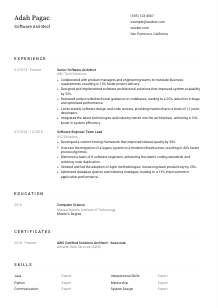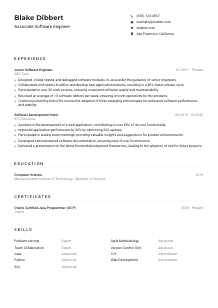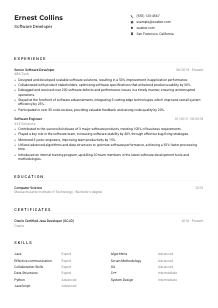Software Architect Resume Example
Designing software blueprints, but your resume feels like an endless loop? Delve into this Software Architect resume example, constructed using Wozber free resume builder. Uncover how effortlessly you can outline your architecture acumen to satisfy job criteria, guiding your career towards sturdy and scalable horizons!

How to write a Software Architect Resume?
Hello, aspiring Software Architect! In the competitive landscape of technology, your resume is not just a document, but a powerful tool that showcases your expertise and skills. If designing complex software architecture energizes you, then you're in the right place. This guide, crafted with insights from the free resume builder, Wozber, will walk you through tailoring your resume specifically for a Software Architect position.
Ready to architect your career's next masterpiece? Let's translate your professional journey into a resume that not only passes the ATS but also captivates hiring managers.
Personal Details
The Personal Details section of your resume is the cornerstone that can either invite hiring managers to read further or have them move on. As a Software Architect, it's crucial to illustrate your professionalism and readiness for the role from the very beginning. Here's how:
1. Name & Branding
Your name is essentially your brand. Use a crisp, professional font, ensuring it's prominent at the top. The designation "Software Architect" beneath your name signals that you're not just any candidate; you're the right fit for this role.
2. Job Title Alignment
Echo the job title from the description just below your name. Aligning with the role's terminology, such as "Software Architect," sets an immediate relevancy to your application, making it more ATS-friendly.
3. Contact Info Essentials
Your phone number and email address are non-negotiables. Make sure your email follows a professional format – "firstname.lastname@email.com." This small detail showcases your attention to professional norms.
4. Geo-Preferences
Mentioning "San Francisco, California" as per the job description underscores that you're in the preferred location, thus minimizing any concerns regarding relocation.
5. Professional Links
Adding a link to your LinkedIn profile or personal portfolio website demonstrates transparency and a willingness to share your professional accomplishments outside the resume. Ensure these are up-to-date and echo the professionalism of your resume.
Takeaway
Your personal details section sets the tone. By keeping it aligned with the job's geographical and professional requirements, you're knocking on the door the right way. Remember, this section is the gateway, so make it inviting and aligned with what the Software Architect role demands.





Experience
In the realm of software architecture, your professional experience serves as the backbone of your resume. It should succinctly yet thoroughly narrate your journey, focusing on achievements that resonate with the Software Architect role. Let's refine it:
- Collaborated with product managers and engineering teams to translate business requirements, resulting in 15% faster project delivery.
- Designed and implemented software architectural solutions that improved system scalability by 25%.
- Reviewed and provided technical guidance on codebases, leading to a 20% reduction in bugs and optimized performance.
- Led bi‑weekly software design and code reviews, providing mentorship to a team of 12 junior developers.
- Integrated the latest technologies and industry trends into the architecture, achieving a 10% boost in system efficiency.
- Developed a custom testing framework that improved release quality by 30%.
- Oversaw the migration of a legacy system to a modern infrastructure, resulting in 40% faster processing times.
- Mentored a team of 8 software engineers, enhancing the team's coding standards and reducing code duplication.
- Initiated and led the adoption of Agile methodologies, increasing team productivity by 20%.
- Optimized database queries and indexing strategies, leading to a 15% improvement in application performance.
1. Dissecting the Job Description
Start by meticulously analyzing the job description. Highlight keywords and phrases related to responsibilities and requirements. These will serve as a checklist to ensure your resume speaks directly to what the employer is seeking.
2. Sequence of Relevance
List your roles chronologically, with the newest first. For each position, clearly state your title, the company's name, and your tenure. Use an ATS-friendly resume format to ensure this information is easily navigable.
3. Achievements That Speak Volumes
For each role, share specific accomplishments that mirror tasks or skills mentioned in the job description. Use metrics wherever possible to lend credibility to your claims. For instance, "Designed and implemented software architectural solutions, driving a 25% improvement in system scalability."
4. Numbers Make a Difference
Quantifying your achievements adds a layer of authenticity and shows the magnitude of your contributions. Whether it's the percentage improvement in system performance or the number of team members you mentored, these details matter.
5. Relevance Is Key
While showcasing your ping-pong championship might add personality, prioritize the experiences most relevant to software architecture. Each detail should underscore why you are the unparalleled choice for this Software Architect role.
Takeaway
The Experience section is your personal showcase. It's where you prove your worth beyond any doubt. Leverage each bullet point to align with the job description, quantifying achievements to make your contributions palpable. Remember, it's your professional narrative, make it compelling and relevant.
Education
For a Software Architect, education lays the foundational knowledge essential for advanced responsibilities. While this section may seem straightforward, finessing it can significantly push your resume ahead. Let's sculpt it to your advantage:
1. Meeting the Bar
The job post specifies a "Bachelor's degree in Computer Science, Software Engineering, or a related field." Make sure your highest relevant degree is listed first. For higher positions like a Software Architect, including your Master's degree, if applicable, showcases a continued commitment to learning.
2. Simplify the Format
Maintain clarity with a simple format: Degree (with specialization if pertinent), Institution, Graduation year. This straightforward presentation respects the reader's time and aligns with ATS optimization.
3. Degree Specification
Explicitly stating your degree in Computer Science meets a primary requirement head on. Tailor this section by directly mirroring language from the job description, confirming you possess the foundational knowledge they seek.
4. Course Highlights (if applicable)
For applicants early in their career or looking to transition, highlighting specific, relevant coursework can underscore your preparedness. However, for experienced roles, focus on degrees and encompassing achievements in the field.
5. Additional Accolades
If you graduated with honors or completed a particularly relevant project or thesis, mention it here. For senior roles like Software Architect, this can elucidate your long-standing excellence in the field.
Takeaway
Your education section isn't just a list; it's proof of your solid foundation in computer science and software engineering – crucial pillars for a Software Architect. Tailor this section to reflect the job's requirements, demonstrating that your educational journey aligns perfectly with what they're looking for.
Certificates
In the evolving landscape of technology, certifications can significantly bolster your candidacy for a Software Architect role. They not only denote your commitment to professional growth but also validate your proficiency in specific areas. Let's curate this section effectively:
1. Relevance to Job Requirements
Since the job description for Software Architect didn't specify certifications, your choice here should directly align with enhancing your qualifications for the role. Opt for those that prove your expertise and ongoing education – like "AWS Certified Solutions Architect - Associate."
2. Quality over Quantity
It's tempting to list all accreditations, but focus on those most applicable to the job. A targeted approach ensures the hiring manager sees only the most relevant certifications, reaffirming your suitability for the role.
3. Transparency Is Key
Listing certificates with their validity period, especially in fast-evolving fields like software architecture, demonstrates your commitment to maintaining current skills and knowledge.
4. Continuous Learning
In technology, stagnation is the antithesis of progress. Highlight your drive for continuous learning by seeking certifications that keep you at the threshold of innovation. This mindset is indispensable for a Software Architect.
Takeaway
Certifications are a testament to your expertise and a commitment to excellence. By selecting certificates that import relevance and freshness to your skills, you're not just preparing for the next step; you're shaping the future of software architecture. Let your dedication to perpetual growth shine here.
Skills
For a Software Architect, presenting a constellation of technical and interpersonal skills can distinguish you in a sea of candidates. Let's strategically construct this section to make it impactful and reflective of the key competencies sought in the job description:
1. Extracting from the Job Ad
Decipher the job ad for both hard and soft skills, ensuring you understand the breadth and depth of what's needed. Skills like "Strong proficiency in multiple programming languages" and "Excellent communication" are golden nuggets you want to mirror.
2. Alignment and Presentation
Map out your skills that directly align with those mentioned in the job description. Prioritize them in your list, creating a blend of technical prowess (e.g., Java, C#, Python) and soft skills (e.g., communication, interpersonal skills) that demonstrate your comprehensive capabilities.
3. Clarity and Conciseness
Resist the urge to overload this section. A concise, meaningful list of skills that addresses the job requirements directly makes for an ATS-friendly resume. This focus keeps the hiring manager's attention on your most relevant skills.
Takeaway
The Skills section is your opportunity to shine a light on your professional toolbox. By carefully selecting skills that match the job description, you demonstrate you're not just a contender; you're the perfect fit. Let your skills paint a picture of an adept, well-rounded Software Architect ready to take on the challenge.
Languages
In the diverse landscape of tech, fluency in multiple languages amplifies your ability to collaborate across global teams. Though not always a core requirement, showcasing linguistic versatility can subtly tip the scales in your favor, especially for roles emphasizing communication:
1. Job Description Alignment
The job posting emphasizes "English fluency." Begin by prominently listing English and your proficiency level. This direct alignment with the job specs answers a critical requirement succinctly.
2. Showcase Additional Languages
After satisfying the primary language requirement, listing additional languages can portray you as a culturally adaptable candidate, potentially invaluable for a diverse team environment.
3. Proficiency Levels
Be honest about your proficiency levels, using terms like "Native," "Fluent," "Intermediate," or "Basic." This clarity helps hiring managers gauge your ability to communicate and integrate into diverse teams.
4. The Role's Scope
For positions with a global influence or those within multinational companies, fluency in several languages can be a significant asset. Even if additional languages were not a job requirement, they underscore your potential for broader communication and leadership.
5. Consider The Company's Culture
Investigate the company's culture and presence on the global stage. If it values diversity and has a footprint in non-English-speaking countries, your language skills could be a distinctive advantage.
Takeaway
While not always a front-row requirement, your language skills reflect versatility and adaptability – traits of immeasurable value in today's global tech landscape. Highlighting these skills on your resume might just be the subtle differentiator making you memorable in a pool of Software Architect applicants.
Summary
The professional summary is essentially your 'elevator pitch' – a concise, potent narrative that encapsulates your expertise and readiness for the Software Architect role. Let's weave a summary that leaves hiring managers eager to learn more about you:
1. Capture the Job's Essence
Comprehensively understand what the role entails and the characteristics the employer values. This insight will be the foundation of your summary.
2. A Strong Opening
Begin with a clear statement about your professional identity, "Software Architect with over 9 years of hands-on experience," immediately affirming your candidacy's relevance to the role.
3. Highlight Your Expertise
Briefly mention key skills and accomplishments, aligning with the role's requirements. Phrases like "Proven track record in collaborating with cross-functional teams" directly echo the job description, reinforcing your suitability.
4. Conciseness is Key
The power of a summary lies in its brevity. Aim for 3-5 impactful lines, creating a teaser that entices the reader to delve deeper into your resume. This is your first impression, make it count.
Takeaway
Your summary is the beacon that guides hiring managers through your resume. Craft it with precision, aligning closely with the job's essence and underscoring your unparalleled fit for the role. Let it reflect your journey, ambition, and the unique value you bring as a Software Architect. It's your moment to shine, succinctly and powerfully.
Launching Your Software Architect Journey
Embarking on your journey with a well-crafted resume can set the stage for a rewarding career as a Software Architect. Remember, every section of your resume should resonate with the role you aspire to secure. By following the steps outlined with examples from Wozber's free resume builder, including utilizing its ATS-friendly resume templates and ATS resume scanner for keyword optimization, you ensure your resume is not just seen but also leaves a lasting impact. Your resume is your narrative woven with precision and insight; let it articulate your readiness to architect not just software but also your future in the technology landscape.
With confidence, creativity, and strategic alignment, your resume will open doors to opportunities waiting to be seized. Go ahead, architect your story, and embark on a journey filled with achievements and professional growth.

- Bachelor's degree in Computer Science, Software Engineering, or a related field.
- Minimum of 8 years of professional experience in software development with expertise in designing and architecting complex systems.
- Strong proficiency in multiple programming languages, such as Java, C#, or Python.
- Proven track record of designing and implementing scalable, high-performance software solutions.
- Excellent communication and interpersonal skills, with the ability to work collaboratively in cross-functional teams.
- English fluency is a critical requirement.
- Must be located in San Francisco, California.
- Collaborate with product managers and engineering teams to translate business requirements into technical solutions.
- Design and implement software architectural solutions, ensuring system scalability, security, and reliability.
- Review and provide technical guidance on codebases, ensuring best practices and optimization.
- Lead software design and code reviews, providing mentorship and feedback to the team.
- Stay updated with the latest technologies and industry trends, integrating innovative tools and practices into the architecture.















